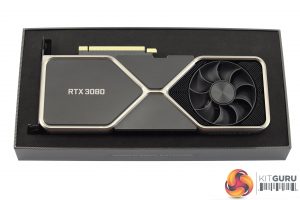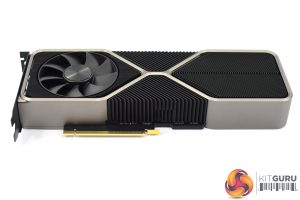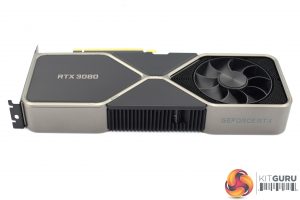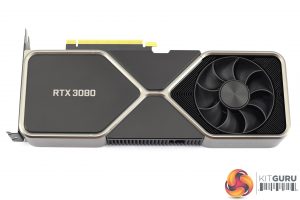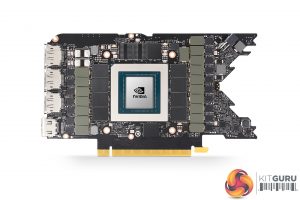The RTX 3080 Founders Edition ships in a new style of box that is largely black, but with some silver accents. The Nvidia logo sits in the top left corner, just above the GeForce RTX branding.
The top of the box (slowly) lifts off to reveal the back of the card, and it does make an excellent first impression – but more on that below.
Underneath the graphics card itself, a small box contains all the included accessories, consisting of a couple of guides and that 2x 8-pin to 12-pin power adapter we looked at in our unboxing.
As for the Founders Edition, in my view this is far and away the best-looking graphics card Nvidia has ever designed. It has a somewhat industrial look to it, with the black heatsink fins and thick metal unibody frame, creating a lovely contrast.
The outer frame, a sort of gunmetal colour, also crosses in a x-pattern through the centre of the card. It's worth noting the card measures 285mm long, and it's 112mm wide, with a standard dual-slot thickness. This means it's almost 20mm longer than the 20-series Founders cards, but it should still fit in most ATX cases.
Of course, the fan layout has been radically overhauled, with one 85mm on the underside of the card pushing air through the heatsink and straight out of the case via the I/O bracket. The fan on the top of the card, next to the backplate, pulls air through the heatsink and exhausts it out into the CPU/memory area of the motherboard/chassis, where the system's exhaust fans can expel the heat.
Speaking of the back of the card, this features the RTX 3080 branding printed towards the I/O bracket, with the fan taking up the right-hand side. It's all very tastefully done, with nothing looking out of place. Even the screws are hidden under small tabs, giving the card a very polished look.
The 12-pin power connector is of course a hot topic, Nvidia claims it opted for this new standard purely as a space-saving measure, though they also say the 12-pin can deliver more power than 2x 8-pins. As the RTX 3080 is a 320W card that isn't strictly necessary just yet, but perhaps GPUs in years to come will continue to increase their rated power draw. For now, the included adapter will get the job done, but it seems every PSU manufacturer is at least working on their own modular 12-pin cables for a neater solution.
For display outputs, RIP to the USB-C VirtualLink connector… but we have 3x DisplayPort 1.4a ports and then, crucially, HDMI 2.1 capable of the full 48Gbps bandwidth. Display Stream Compression is also supported, so you could even use this port for 8K/60Hz output with HDR enabled.
PCB and cooler images courtesy of Nvidia.
Lastly we come to the PCB and cooler. Please note – I have not disassembled the Founders Edition card that Nvidia sampled us with, the above images are stock photos provided by Nvidia directly.
Even so, the triangular PCB is highly unusual, but don't fret – it is exclusive to Nvidia's Founders Edition card, and isn't the reference design. AIB partners like Gigabyte, ASUS, MSI etc will be using traditional rectangular PCBs. Though I would like to see EKWB come up with a triangular waterblock….
Everything on the PCB is so tightly placed, Nvidia tells us it was really trying to remove as much obstruction to the airflow as possible, hence the new design and triangular cutout. What we can see is a total of 18 power stages, 15 for the GPU and 3 for the memory, while we know the 10GB GDDR6X is manufactured by Micron.
The cooler uses a hybrid approach, with a vapour chamber plate contacting the GPU die, with four heatpipes transferring the heat from that chamber out into the fin array, which is then dissipated by the airflow from the two fans. It makes complete sense on paper, but we test cooling and noise levels later in the review.
 KitGuru KitGuru.net – Tech News | Hardware News | Hardware Reviews | IOS | Mobile | Gaming | Graphics Cards
KitGuru KitGuru.net – Tech News | Hardware News | Hardware Reviews | IOS | Mobile | Gaming | Graphics Cards



